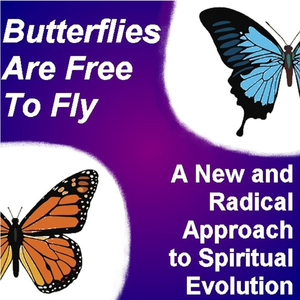When Nicolaus Copernicus discovered the Earth wasn’t the center of the Universe, everything changed. When Isaac Newton figured out the law of gravity from a falling apple, everything changed. When Benjamin Franklin harvested electricity from lightening and Thomas Edison made the first commercial light bulb, everything changed. Today, when quantum physicists realize our physical universe isn’t real, that it’s just a hologram, everything ... wait! Nothing’s changed - yet. "Butterflies Are Free To Fly" offers a new and radical approach to spiritual evolution based on the recent scientific experiments in quantum physics and brain research outlined in Part One. Given that the physical universe which looks and feels so real to us is actually a unique holographic projection from our own brain, the author examines various models for life and living that are very different than what we have been told and taught. “This is the only radical thinking that you need to do,” Dr. Amit Goswami is quoted as saying. “But it is so radical, it is so difficult, because our tendency is that the world is already ‘out there,’ independent of my experience. It is not. Quantum Physics has been so clear about it.” For example, in Part Two we are introduced to something the author calls an “Infinite I,” which is creating our unique holographic experiences. Then there is the “Human Game Model,” offering explanations all the way from why we experience pain and suffering to how we can change our reactions and responses by letting go of our judgments, beliefs, opinions, and fears. The end result, suggests the author, is peeling away all the layers of false identities that make up the “ego,” transforming and emerging from our cocoon as a “no-self.” Part Three of the book is a series of questions and answers to offer alternative explanations consistent with these models on subjects such as money, past lives, karma, trust, and the “Earth Environment.” This book will leave you thinking, because this book is truly radical. "I devoured your book. I appreciate your personal insights and sharing. Thanks again for a brilliant read." - Nancy, from California "Thank you so much for putting up such a wonderful book..I have no words to describe how I feel Now after I read the book." - Charles, from Nigeria "Thank you for your book. It is refreshing to see something that is both free and very accurate. I gained so much from the book. Your work explains for free so much truth in simplicity that I know to be correct. The quantum physics material is brilliant." - Andy, from Thailand "Appreciate your book in many many ways... Its a total masterpiece!" - Daniel, from Colorado "This has been an incredible read and I can't stop thinking about it. I'm definitely recommending it to others." - Jace, from Canada "Really enjoying your book , brilliantly put together." - Tink, from Amsterdam "I have read the book and I must say that I have never ever been so absorbed in a book. Your viewpoint is so fresh and logical. The way you have incorporated the quantum physics aspect is spellbinding. I am simply overwhelmed by your imagination and the ability to communicate so clearly." - Harmeet, from Belgium "Best book I have!" - Kenneth, from the USA "Loved the book." - Mike, from Oregon "An original and well designed book of the mind that offers the reader the path to understanding the true nature of our reality and therefore the real path to peace." - Gary, from Canada

